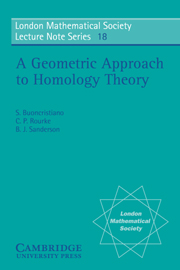I - Homotopy functors
Published online by Cambridge University Press: 05 April 2013
Summary
The main purpose of this chapter is to axiomatise the passage from functors defined on pl cell complexes to homotopy functors defined on polyhedra. Principal examples are simplicial homology and mock bundles (see Chapter II).
Our main result, 3. 2, states that the homotopy category is isomorphic to the category of fractions of pl cell complexes defined by formally inverting expansions. Thus to define a homotopy functor, it is only necessary to check that its value on an expansion is an isomorphism. Analogous results for categories of simplicial complexes have been proved by Siebenmann, [3].
In §4, similar results are proved for ∆-sets. This gives an alternative approach to the homotopy theory of ∆-sets (compare [2]).
In §6 and §7, we axiomatise the construction of homotopy functors and cohomology theories. Here we are motivated by the coming application to mock bundles in Chapter II, where the point of studying cell complexes, rather than simplicial complexes, becomes plain as the Thorn isomorphism and duality theorems fall out.
The idea of using categories of fractions comes (to us) from [1] where results, similar to those contained in §4 here, are proved.
Throughout the notes we use basic pl concepts; for definitions and elementary results see [4, 6 or 8].
DEFINITIONS
Ball complexes
Let K be a finite collection of pl balls in some Rn, and write ∣K∣ = υ{σ:σ ∈ K}, Then K is a ball complex if
(1) ∣K∣ is the disjoint union of the interiors of the σ ∈ K, and
(2) σ ∈ K implies the boundary is a union of balls of K.
- Type
- Chapter
- Information
- A Geometric Approach to Homology Theory , pp. 4 - 18Publisher: Cambridge University PressPrint publication year: 1976



